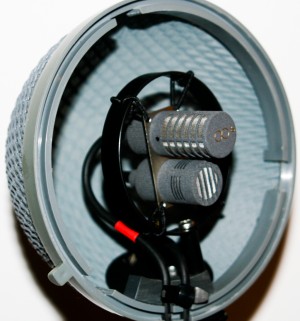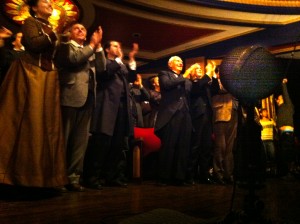M/S STEREO RECORDING TECHNIQUE IN SOUND PRODUCTION AND POSTPRODUCTION
 Given that M/S stereophonic recording theories and practices have existed for over fifty years, many people are still reluctant about its regular use during production or post production, especially during the sound editing and mixing stages. Recent improvements in post-production softwares, along with an increase in computing DSP power, facilitate the integration of this type of recording technique throughout the entire work process.
Given that M/S stereophonic recording theories and practices have existed for over fifty years, many people are still reluctant about its regular use during production or post production, especially during the sound editing and mixing stages. Recent improvements in post-production softwares, along with an increase in computing DSP power, facilitate the integration of this type of recording technique throughout the entire work process.
For some background, the Mid-Side (or M/S) recording technique is a coincident miking technique developed by Alan Blumlein, which captures sound from a fixed point in space using two microphones. It provides a natural stereo image that can be easily adjusted or modified after the recording process. There are several plug-ins that allow you to modify the reproduction of sound in space; amongst them the Waves plug-in S1 (stereo imager) and M/S decoder (MS Matrix), which are commonly used by many studios and professionals. Based on similar matrixing theories are ambisonic recording techniques, which were popularized by the Soundfield microphones and more recently the Double M/S, proposed by Schoeps, arise from the same mathematical theories about the sphere.
One of the most recognized assets of the M/S technique is its versatility and ease of capture. It can be used as a mono cardioid microphone (M) pointed towards the source. During shooting, it can serve as a primary or secondary boom, and for wild recordings it is suitable for recording sound effects, voices, or even music given the circumstances. For ambience recordings it can give a natural stereo image. Due to the extreme proximity between the two microphones, phase problems are avoided, such as those commonly caused by differences in space and angles between the microphones. One down side of this technique is a less defined stereo separation when compared to other stereophonic recording techniques that have greater spacing between microphones, such as AB or ORTF.
Adding a close M/S pair during a shoot can be used to add detail to busy scenes, or if recorded from a distance, can enhance the atmosphere surrounding the action. These ambience tracks can later be used as a part of your sound library for the project. I benefited from this recently, which I describe in my article about the film War Witch.
 During sound editing, we can also dig into the source recordings from alternate takes to boost and enlarge ambiences or crowd atmospheres.
During sound editing, we can also dig into the source recordings from alternate takes to boost and enlarge ambiences or crowd atmospheres.
There is often confusion about what to do with the M/S recordings during the editing stage. To clear this up, they should be separated into two categories: dialogue and sound effects. This choice should reflect their expected functions in the final mix. If using your M/S pair as secondary on-location dialogue boom the tracks should be grouped and sorted with the primary dialogue recordings, whereas if your M/S pair is capturing atmospheres (without voices) the tracks should be handled by the sound effects editor, and later treated as a sound effect by the mixer. If used as a sound effect, the M/S tracks will more likely be processed and mixed in stereo, or even surround. Though be sure not to duplicate the sounds into both categories, because if synced by both the dialogue editor and the sound effects editor, phase problems will occur from having duplicate tracks.
When recording sound effects with an M/S pair, I commonly use only one of the two recorded mono tracks for the final sound effect; re-recording mixers will take care of its location in space through panning. The M and S sources capture different qualities of the event, and often one is better suited for the particular sound. The cardioid front microphone (M) has qualities that make it ideal for sound effects recording: pronounced transients, a specific point of view, and limited ambient sound. The bidirectional microphone (S) can also be used as a mono source; it is less sensitive to low frequencies and gives a more distant perspective on the subject. Transients are also less pronounced, resulting in more tamed dynamics. It gives a very different sound than the M, which can be an asset if the M has a problem, such as distortion, or if you want to have a more distant or diffused sound.
Contrary to sound effects, when recording ambiences with an M/S pair, I commonly use both the M and S tracks to populate the stereo field adjusted according to the need.
During my first years of sound editing, we had dedicated editing tracks for M/S, which were routed to an outboard analogue M/S decoder during the mix. This technique allowed the re-recoding mixer to change the stereo image in real time, playing with the relative levels of the M and S before sending it to the decoder. This allowed the re-recording mixer to make live (fader) adjustments to the M/S stereo balance in the context of the overall mix. With the transition from analog to digital technology and the shift towards virtual mixing in computers, it is now common practice to simply use an M/S decoder during sound editing, removing the ability to change the relative M/S levels in real time during a mix. In recent years I have started to provide un-decoded M/S sources, leaving the choice of M/S balance to the re-recording mixer. Using internal routing and a combination of plug-ins there is new range of possibilities, including surround assignation. Imaging plugins respond very well to M/S sources, decoded or not, especially when one wants to produce a coherent and natural atmosphere in the three front speakers (LCR) of a 5.1 setup. This greatly reinforces the perception of reality of a scene, helping to blend the on location sounds with the different elements of sound design.
Certain precautions must be taken during the decoding process to avoid problems in the final LtRt format (Dolby Surround), which is still used in older theaters and television. An extreme Decoding of the S component (the sides) compared to M (center) will give a wider stereo image but will emphasize out-phase components between the left and right channel. These components will be interpreted by the Dolby Surround Matrix as surround elements because the matrix uses out of phase elements to create the surround track. Also, as a precaution, I decode the M/S sources prior to altering or applying effects processing in order to avoid problems that can arise from attempting to decode processed sounds.
M/S recording provides great flexibility at all stages throughout the production and post production processes, and it is important to recognize the needs of each scene in order to best employ your M/S recordings.
Writing this article forced me to clarify my practice and observations that I gathered with my fellow sound editors and re-recording mixers, along with internet prowling. As always, when I try to deepen my knowledge of a subject I am faced with an even larger part of my ignorance. Opinions, impressions, corrections, and additions are welcome in the comments.
Here are some more technically detailed articles and documents that I found very useful on the net about M/S recording:
http://designingsound.org/2011/08/tim-nielsen-special-ms-recording/
http://thesoundmyheadmakes.blogspot.ca/2012/09/quad-miking-dual-ms-update.html
